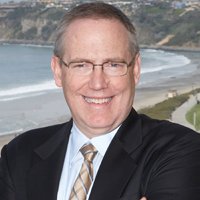This year we have been working to deliver a “CPO Rising Virtual Roundtable” series, sponsored by IBM. Each of the roundtables brings together three or four leading Chief Procurement Officers to discuss a specific topic in depth and share their insights, experiences, plans, and recommendations. In each of these, I serve as host and moderator (click link to listen).
Today’s article is the next installment in the Chief Procurement Officer Roundtable series, wherein we’ll profile Mr. Thomas Linton, Chief Procurement and Supply Chain Officer at Flextronics, International. We’ll also take a look at Flextronics, particularly its procurement operations, and how Tom has championed collaboration, communication, and betting on yourself and your team to deliver superior performance for your company.
Tom began his career at IBM, where he spent 20 years developing and founding several worldwide Trading and Technical Centers, including serving as the Director of Global Hardware Procurement. After IBM, Tom helped found E2Open, Inc., a provider of cloud-based, on-demand supply chain software. Subsequent roles for Mr. Linton include serving as Chief Procurement Officer (CPO) at Agere Systems, CPO and Vice President at Freescale Semiconductor, and more recently, Executive Vice President and CPO at LG Electronics.
In addition to his role at Flextronics, Mr. Linton serves as the Chairman of the Board for the Institute of Supply Management (ISM), and serves on the World Economic Forum’s Global Agenda Council for Logistics and Supply Chain. Tom is a graduate of the University of Vermont, and has been a guest lecturer at MIT – one of 12 institutions of higher learning where he has guest lectured. Even though Tom primarily works in San Jose, California, he views the business from an East Asian perspective, drawing on his 22 years spent living in Japan, Korea, and Singapore, where Flextronics is headquartered and where he also has an office. As he told me, “I tend to think of things from that perspective. And in the electronics industry from where I sit, understanding that is really, really critical.”
Flextronics is a $26 billion, industry-leading, Fortune Global 500, end-to-end supply chain solutions company with a global workforce of 200,000 and operations in over 30 countries. As Tom told us, he and his team manage supply chains for about 1,000 customers worldwide. With 14,000 active suppliers, Tom and his team manage the supply chain relationships with their customers, each of whom Tom notes has different requirements. They also manage about $21 billion in direct and indirect spend plus all the logistics spend for the company, as well as all the materials management, which involves inventory management and all the site-level procure-to-pay (P2P), and order execution. Tom says that his team also “drives the supply chain design and the structures that go into managing that level of complexity.”
One of the things that Tom noted was that, as procurement professionals, his team is in the business of spending other people’s money. As a result, internal stakeholders are always interested in their work – what they’re procuring, how they’re procuring, money spent – which can be a point of friction between vested stakeholders. As he told us, “The difference between professional acquisition – not just at a category, commodity, or supplier level – but actually the integrated way by which you plan, forecast and execute, I think, is…that we’re usually a victim of friction in how either communications or materials and processes flow.”
To mitigate these concerns, Tom is a firm believer in strong communication between internal stakeholders, particularly with his company’s high velocity, high volume supply chain. He and his team have models for how they communicate procurement plans and strategies; and they’re even working on predictive models for what they need to communicate to stakeholders.
But there’s more to it than just effective communication. When dealing with such high volumes of materials and inventory and speed across a global supply chain, it is more difficult but increasingly important to logistically manage it. This is where collaboration becomes critical. Tom and his team are religious – militant, even – about internal and external collaboration, because if they’re not, he thinks the forces that want to separate are greater than the forces that want to combine. Accordingly, his team has spent a lot of time on that and trying to measure it. Tom firmly believes that you have to measure not only cost performance, but also collaboration at all levels – from the company level down to the individual.
Tom also believes in the power of betting on yourself and your team to elevate your company to the next level of performance. Taking a page from Gene Richter’s IBM playbook from the 1990s, Tom has on a number of occasions put himself out on the line by promising internal stakeholders that he and his team can deliver X or Y results if they provide him with Z resources. As he said, “You have to walk in and say, ‘Look, I have enough confidence in the professional capabilities of my people and of what professional procurement is, to know that we’re going to take X percent out of this in the next 12 months or next 24 months.’ And [then] use that as a lever to get resources, budget, and what you need in order to go do it.”
When Tom is not leading the charge for his team, he is leading other projects that take advantage of his company’s position in Silicon Valley. Recently, Flextronics “spun out a company [they] incubated called Elementum, which is working on cloud-based supply chain solutions.” Elementum was spawned from their experience working with Workday, Inc. and HR.com. Tom and his team are also doing some interesting work with “next-generation predictive capabilities around the supply chain and sourcing.”
It was great speaking to Tom about his experiences at Flextronics, and hearing him discuss the importance of communication and collaboration, both internal and external, and their importance to CPO success. These are all key themes that we consistently stress here on CPO Rising, and it was affirming to hear Mr. Linton echo in this Roundtable event.
Although our profile series from the first Roundtable event is coming to a close, Andrew Bartolini, Publisher of CPO Rising, will offer a retrospective of the series in the coming weeks. Be sure to tune in then.
RELATED ARTICLES
Growth and Expansion – the Archer Daniels Midland Way
Alicia Ralston: Sowing the Seeds of Collaboration at Archer Daniels Midland
An Agent of Change: Dr. Nick Nayak’s Impact at the Department of Homeland Security
DHS Procurement: Securing the Homeland, One Purchase at a Time
Dr. Nick Nayak – A Profile of a Public-Sector Chief Procurement Officer
Announcing The 2014 Chief Procurement Officer (“CPO”) Virtual Roundtable Series


